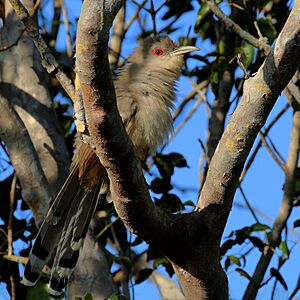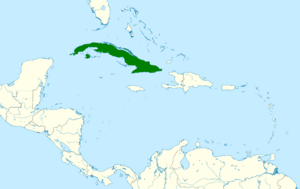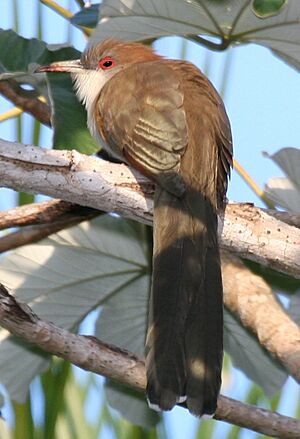Great lizard cuckoo facts for kids
Quick facts for kids Great lizard cuckoo |
|
|---|---|
 |
|
| C. m. santamariae Cayo Coco, Cuba |
|
| Conservation status | |
| Scientific classification | |
| Genus: |
Coccyzus
|
| Species: |
merlini
|
 |
|
| Synonyms | |
|
|
The Great Lizard Cuckoo (Coccyzus merlini) is a fascinating bird that belongs to the cuckoo family. You can find this special bird living in the warm islands of the Bahamas and Cuba. It's known for its long tail and its habit of hunting lizards!
Contents
Understanding the Great Lizard Cuckoo
Scientists like to group living things to understand them better. The Great Lizard Cuckoo is part of the cuckoo family, called Cuculidae.
Different Types of Great Lizard Cuckoos
For a while, the Great Lizard Cuckoo and three other types of lizard cuckoos were thought to be one single species. Now, scientists know they are separate but very closely related. They are all part of the Coccyzus group of birds.
There are four main types, or subspecies, of the Great Lizard Cuckoo:
- C. m. bahamensis (found in the Bahamas)
- C. m. santamariae (found near Cuba)
- C. m. merlini (found on Cuba's main island)
- C. m. decolor (found on Isla de la Juventud)
Sometimes, the C. m. bahamensis type is called the Bahama Lizard Cuckoo. The other three types are sometimes grouped as the Cuban Lizard Cuckoo.
What Does the Great Lizard Cuckoo Look Like?
The Great Lizard Cuckoo is the biggest bird in its group, Coccyzus. It can be anywhere from 42 to 54 centimeters (about 1.4 to 1.8 feet) long. About half of its length is its very long tail! It usually weighs between 100 and 155 grams (about 3.5 to 5.5 ounces).
Colors and Features
Both male and female cuckoos of the same type look alike. However, males are usually a bit bigger than females. Their beak is long and mostly straight. The top part of the beak is dark, and the bottom part is lighter.
The most common type, C. m. merlini, has an olive-brown head and back. When it flies, you might see a reddish-brown color on its wing feathers. Its throat is whitish, its chest is light gray, and its belly is a reddish-brown. Its tail feathers are gray with wide white tips. Around its eye, there's a patch of bare skin that can be red or orange. Young cuckoos have slightly different tail feathers and yellow skin around their eyes.
Differences in Subspecies
- C. m. santamariae is a bit smaller and lighter in color than the main type. It also has a longer beak.
- C. m. decolor has more grayish-brown feathers on its back and a shorter beak.
- C. m. bahamensis looks quite different. It's smaller, has grayer feathers on its back, and a light brown wash on its belly. All its tail feathers have a black band near the end.

Where Do Great Lizard Cuckoos Live?
Each type of Great Lizard Cuckoo lives in specific places:
- C. m. bahamensis lives on islands in the Bahamas like Andros, New Providence, Eleuthera, and Harbour Island.
- C. m. santamariae lives on many small islands off the north-central coast of Cuba.
- C. m. merlini lives on the main island of Cuba and some small islands nearby.
- C. m. decolor lives on Isla de la Juventud, also known as the Isle of Pines.
Preferred Homes
These cuckoos are not picky about where they live! The Cuban types can be found in many different places. These include thick forests, younger forests, grassy areas, and even pine forests. They live from sea level up to at least 1,250 meters (about 4,100 feet) high. The Bahama type also lives in various forests, scrublands, and even coffee farms. They especially like forests with lots of vines.
Great Lizard Cuckoo Behavior
The Great Lizard Cuckoo is known for its interesting habits.
Movement and Travel
Scientists believe that the Great Lizard Cuckoo does not travel far. It usually stays in the same area its whole life.
What Do Great Lizard Cuckoos Eat?
This cuckoo is a very flexible eater! It hunts for food mostly in the middle and upper parts of trees. It runs along branches and glides from tree to tree. It also spends a lot of time hunting on the ground, where it can run very fast.
While we don't have all the details about its diet, we know it eats many things. It loves to eat lizards, which is how it got its name! It also eats many kinds of insects, baby birds, frogs, snakes, and sometimes even small mammals. Occasionally, it might eat seeds or fruits.
Reproduction and Life Cycle
We don't know a lot about how the Great Lizard Cuckoo raises its young, especially in the Bahamas. In the Bahamas, they seem to breed in April and May. On the main island of Cuba, their breeding season might last from April to October.
Their nest is like a shallow dish made of twigs and lined with leaves. They usually build it in a tree or bush with thick leaves, not too high off the ground. A female cuckoo usually lays two or three eggs. We don't know how long the eggs take to hatch or how long it takes for the young birds to leave the nest.
How Do Great Lizard Cuckoos Communicate?
The main sound the Great Lizard Cuckoo makes is called the "Long Call." It sounds like a throaty ka-ka-ka-ka-ka-ka-kau-kau-ko-ko. The sound gets louder and faster in the middle, then slows down again. They can make this call at any time of day, but not all the time.
They also make other sounds, like a single strong Chuk note followed by a low, rough sound called the "Groan." They also have sounds called the "Chuckle" and the "Screech." All the different types of Great Lizard Cuckoos sound pretty similar.
Status and Conservation
The IUCN (International Union for Conservation of Nature) helps track how many animals are left in the wild. They look at the Cuban and Bahama Lizard Cuckoos separately.
Cuban Lizard Cuckoo Status
The Cuban Lizard Cuckoo (which includes three subspecies) is listed as "Least Concern." This means there are still many of them, and they live in a large area. Their population seems to be stable, and there are no big threats right now.
Bahama Lizard Cuckoo Status
The Bahama Lizard Cuckoo is listed as "Near Threatened." This means it could become endangered in the future. It lives in a very small area, and there are only an estimated 2,500 to 10,000 adult birds. We don't know if their numbers are going up or down.
Some things that could threaten the Bahama Lizard Cuckoo include new roads, farms, fires, and animals like wild cats and rats. Rising sea levels due to climate change could also harm their homes.




